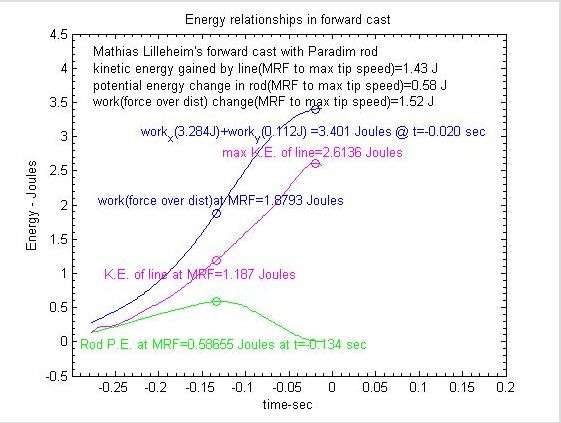Bernd,If I wanna know how much is done by only straightening of the rod, I think I can't rotate the rod!?
That is correct. If you just want to restrict the input energy source to just the PE in the rod then you must restrict the distance the tip moves as it unloads to be equal to the initial tip deflection. Clamping the rod butt so it cannot rotate should do just that.
As you know not all of the PE in the rod is going to be converted to KE in the line. in your experiment some of the elastic energy in the rod will go to moving the mass of the rod. I think Merlin gets an estimate of that loss by comparing the effective mass of the rod (m0) to the mass of the line. Thus if you were casting 7 g of line and the rod had a m0 of 3 g then about 3/(3+7) or 30% of the PE in the rod would be lost in terms of converting it to line speed.
Same thing with the deflection of the rod in casting. Some of the deflection that you see results from inertial bending of the rod due to its own mass. Thus the actual acceleration force on the line is less than the F= -k*x spring force you measure from static deflection measurements. Dr. Spolek has estimated that around 30% of the deflection in a cast comes from inertial bending. Thus the actual acceleration force being applied to the line is around F=-k*(.7*x).
I did not take that factor into account when I computed the energy curves shown earlier. That is why the apparent work energy computed by the force over distance calculation (the dark blue curve below) was some 3.4/2.6 (30%) higher than the KE of line shown in the magenta curve. Drag losses on the line and the rod would also be part of that difference.
I was surprised that no one asked about the "why" of those energy curve differences earlier. It makes me wonder if most readers did not understand what those curves were trying to show.

That is also true. When you hold the rod while making a bow and arrow cast you will instinctively rotate the rod butt forward when the line is released. That will add to distance the tip travels as it unloads and thus will produce more line speed than had it been clamped as you did in your experiment.Otherwise I would have hold the rod and add rotation, too.
Gordy
